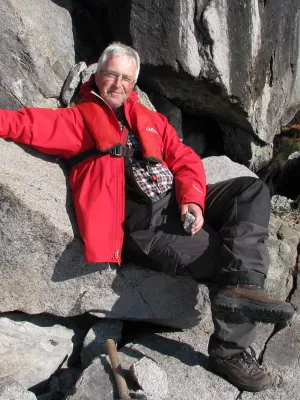
Leif Johansson
Professor emeritus

High-grade localized metasomatic alteration of the granitic gneiss surrounding a clinopyroxene-rich pegmatoid dyke: Sondrum stenhuggeriet, Halmstad, SW Sweden
Author
Summary, in English
The Sondrum stone quarry (Halmstad, SW Sweden) exposes a transition from migmatized granitic gneissic country rock into a foliated clinopyroxene-free granitic gneiss, and then a central pegmatoid dyke dominated by clinopyroxene megacrysts. This transition zone represents a fracture-controlled, fluid-alteration zone that developed under conditions of 650-700 degrees C and 790MPa. Mineral chemical trends in F, Cl, Fe, Ti, Mn and Y are interpreted as documenting a fluid infiltration event associated with the formation of the pegmatoid dyke. Fluid inclusions from the pegmatoid dyke are CO2 dominant, whereas in the surrounding country rock they are dominated by H2O-NaCl-CaCl2. Fluid inclusions from the intermediate foliated clinopyroxene-free granitic gneiss are a mixture of the two types. The pegmatoid dyke appears to have originated from a high Ca activity, Fe-Mg enriched, fluid-rich granitic melt with a CO2 component, which was emplaced along a tectonic fracture in a regionally migmatized granitic gneiss in the lower crust. This was accompanied by limited partial melting of the surrounding granitic gneiss. The Ca activity of the melt was high enough to allow for the formation of clinopyroxene megacrysts as opposed to orthopyroxene. H2O-enriched fluids expelled from the crystallizing pegmatoid dyke, which retained the majority of the CO2 helping to stabilize the clinopyroxene. The expelled fluids coarsened and chemically affected the surrounding country rock resulting in trends in the mineral and fluid inclusion chemistry seen today in the foliated and regional granitic gneiss.
Department/s
- Lithosphere and Biosphere Science
Publishing year
2014
Language
English
Pages
389-416
Publication/Series
Journal of Metamorphic Geology
Volume
32
Issue
4
Document type
Journal article
Publisher
Wiley-Blackwell
Topic
- Geology
Keywords
- clinopyroxene
- fluid inclusions
- granite pegmatoid
- granulite facies
- Sondrum stone quarry
- Swedish Granulite Region
Status
Published
ISBN/ISSN/Other
- ISSN: 0263-4929

